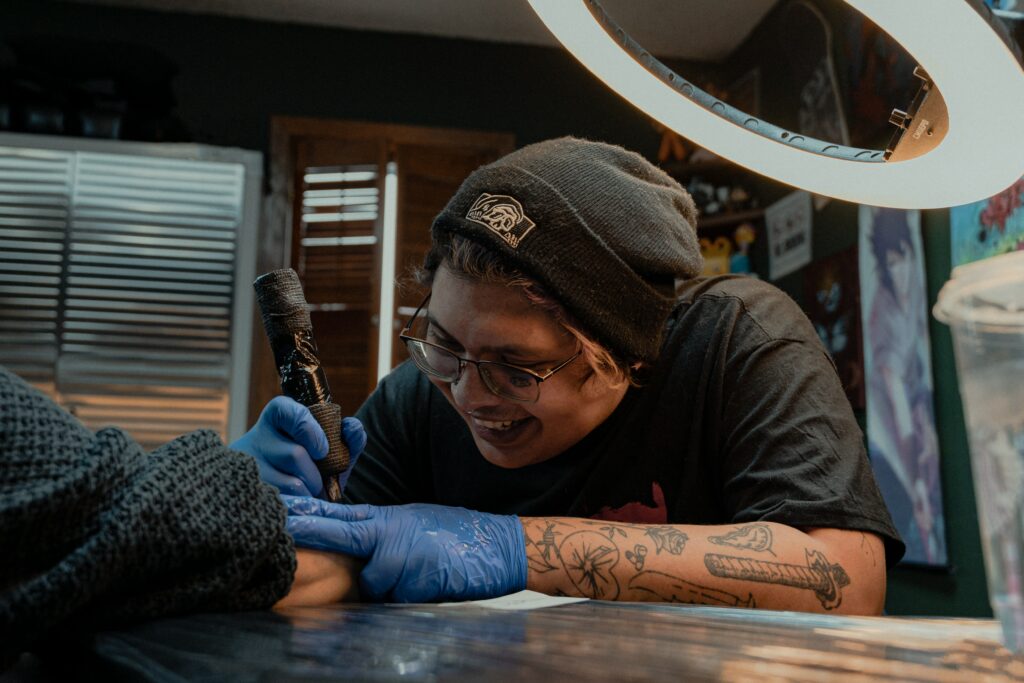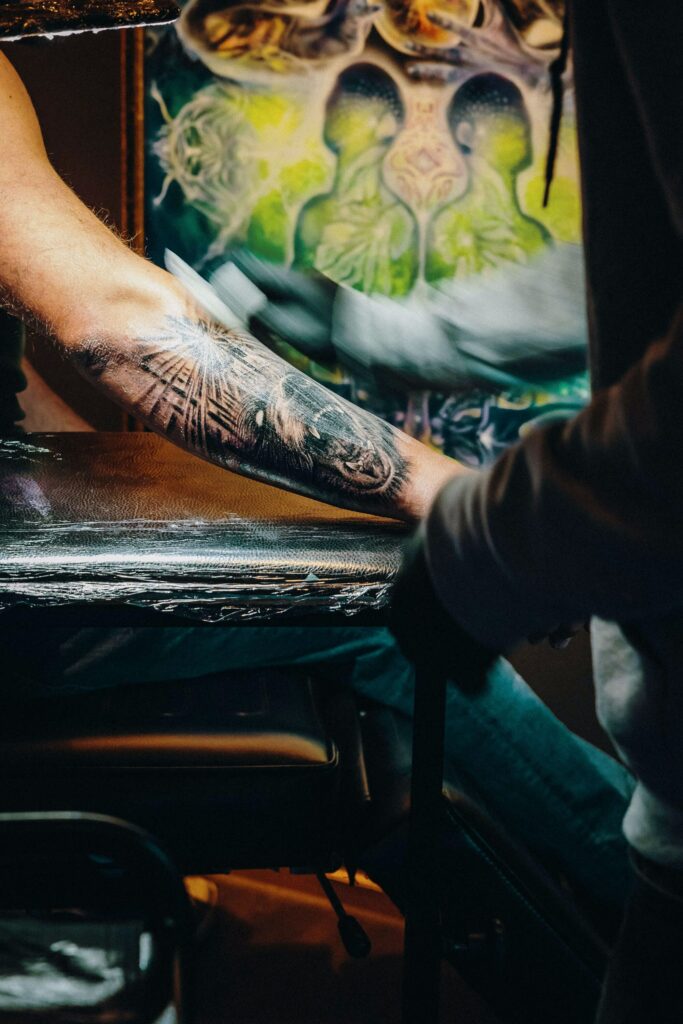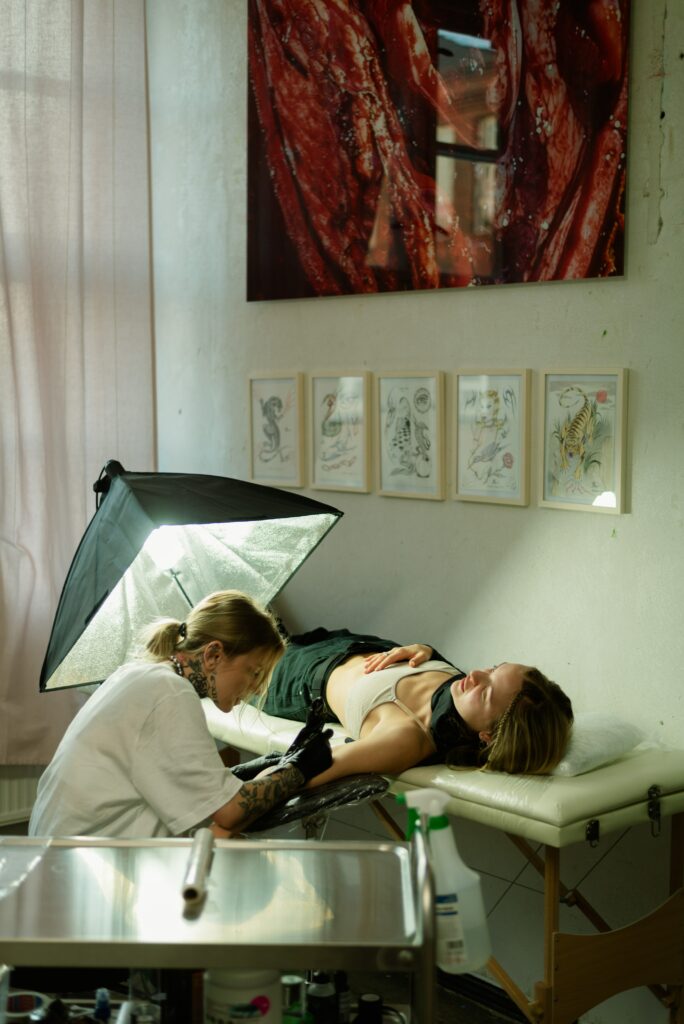Table of Contents
There’s a lingering, unspoken truth that swirls around the buzz of the tattoo gun – the wince-inducing dance of the needle on the skin. It’s a ritual as old as time, an exchange of pain for beauty. But wouldn’t it be wonderful if we could tip the scales, ease that bite, and make the journey to inking as tranquil as the art itself?
Enter the backstage heroes of the tattoo world: Tattoo numbing creams. These humble tubes of magic promise to dull the dragon’s fire, making the tattoo experience more of a ballet than a battle.
My buddy Joe, a hardy trucker with arms that tell tales of his travels, swears by his numbing cream. “Without it,” he confesses with a sheepish grin, “I’d still be a blank canvas.”

Then there’s Lisa, a single mom who decided to immortalize her children’s names in a delicate shoulder piece. She recounts how the numbing cream was a lifesaver, letting her focus on the emotional significance of her tattoo rather than the physical discomfort. “I barely felt a thing,” she said, her smile as bright as her new ink.
These tales echo from tattoo parlors across the world. Whether it’s your first time braving the needle or you’re a seasoned veteran adding to your body of art, the prospect of a less painful experience is universally appealing. So let’s navigate the ins and outs of these game-changing creams. From their composition to their efficacy and everything in between, let’s see if we can make your next tattooing adventure an easier ride.
Tattoo Numbing Creams: Everything You Need To Know
Let’s break down the science behind these tubes of relief. Tattoo-numbing creams work by using key ingredients to interfere with pain signals before they reach your brain. Lidocaine, a local anesthetic, is the front-runner here, helping to dull the sensation of pain at the skin’s surface. Yet, it won’t numb deep enough to block all tattoo pain—it’s there to take the edge off.
To reinforce lidocaine’s work, we bring in nerve blockers like tetracaine and benzocaine. They help manage the pain that lidocaine can’t quite catch. Think of them like a trusty sidekick to our numbing superhero, Lidocaine.
Then, we have the unsung hero, epinephrine. This vasoconstrictor helps extend the numbing effect by slowing the absorption of the anesthetic. Plus, it can limit bleeding and swelling during your session—bonus points for epinephrine!
Don’t fret over safety, either. These creams have the FDA’s nod of approval and are generally regarded as safe. Just remember: moderation is key. Nobody wants to see you overdo it and risk complications. And let’s not forget, as with any product, individual experiences vary. Some may find their pain is heightened when the cream’s effects wear off. Others might have allergic reactions, and in some cases, the cream could affect the final tattoo design. It’s always worth chatting with your tattoo artist before slathering yourself in the stuff.

But the wonders of these creams extend beyond tattoos. Picture this: Kim, a marathon runner and sun worshipper, who swears by numbing cream to soothe severe sunburn. Or George, a senior citizen battling arthritis, who finds relief for his joint pain in these creams. Even for those dealing with nuisances like scabies or hemorrhoids, numbing creams can offer a quick respite.
Now, let’s dish some truth. Not all tattoo artists are on the numbing cream bandwagon. Some see pain as an integral part of the tattoo experience, making the final piece all the more meaningful. Others worry the cream might interfere with their craftsmanship. However, if a client specifically requests it, most are happy to oblige, eager to make the experience as comfortable as possible.
Before you embark on your numbing cream adventure, let’s cover some basics. Choose your cream wisely—not all are created equal. Make sure you arrive at your tattoo session clean and freshly shaven, and let your artist handle the cream application. Leave the cream on for the recommended time to let it do its magic, then have your artist clean off any excess before they start. And remember, just like tattoos themselves, these creams are not a decision to make lightly. Take the time to understand them, and you’re set for a smoother ride on your tattoo journey.
The Best Tattoo Numbing Cream Brands Are….
Zensa

Holding a reputed place at the top of our list, Zensa Topical Anesthetic Numbing Cream emerges as the champion, winning the hearts of professional tattoo artists and enthusiasts worldwide. What sets Zensa apart is its respectful relationship with the tattooing process, ensuring that your artist’s creativity flows uninterrupted and your skin’s story unfolds without the distraction of discomfort. One of our faithful readers, Sara, recalled how she was apprehensive before her first large-scale tattoo but Zensa, her knight in a cream tube, made the entire process a breeze.
Uber Numb
Playing a long game is the Uber Numb Topical Numbing Cream, famous for its extended innings in the field of pain alleviation. This fast-acting, enduring numbing agent has served as a lifeline for thousands about to embark on their first tattoo journey or daring to dive into the realm of piercings. However, with its non-FDA approved status, it would be wise to test a small sample on your skin, ensuring you’re not allergic. Our dear reader, Jake, shared a tale of how Uber Numb saw him through his marathon 6-hour session of an intricate sleeve tattoo.

TKTX Numbing Cream
In the realm of top-tier ingredients, TKTX Numbing Cream is the standout. Offering a myriad of potent elements, each plays its part to prevent inflammation, swelling, and pain during the tattoo or piercing process. Despite its effectiveness, we must advise those with pre-existing medical conditions, expecting or nursing mothers, or those with allergies, to refrain from using TKTX.
Deeveeant Topical Numbing Cream

Now, let’s explore the Deeveeant Topical Numbing Cream, an Amazon superstar, often providing a softer landing as the numbing sensation gradually fades, preventing the sudden onslaught of delayed pain. Suited for shorter tattoo sessions, this cream boasts targeted and specialized effects. Our reader, Mia, recalled how the gradual wear-off of Deeveeant helped her manage the after-session tenderness during her first tattoo experience.
Ink Scribd Premium Tattoo Numbing Cream
Our final contender, Ink Scribd Premium Tattoo Numbing Cream, takes the crown for swift action. Concocted specifically to soothe the pain during a tattoo session, Ink Scribd also demonstrates its versatility in other skin procedures like hair removal and micro-needling. Tattoo artists sing its praises for not just its numbing effect, but also for promoting faster tattoo healing. As our reader, Tom, put it, “Ink Scribd makes the journey towards your tattoo as memorable as the artwork itself.”

Now, do tattoo artists embrace these numbing creams? Well, the honest answer is: not unless specifically requested by a client. You see, in the vibrant culture of tattooing, many artists and enthusiasts hold the belief that the sting of the needle is part of the transformative process, giving the resulting artwork a deeper, more personal significance. Furthermore, there’s a concern that numbing creams might interfere with the artistry, making it challenging to produce the desired design.
Take, for instance, the experience of Lucas, a veteran tattoo artist we spoke with. He once had a client whose numbing cream wore off midway through an elaborate design. The session became quite challenging as the discomfort kicked in. However, he was quick to add, if a client specifically asks for numbing cream, they happily oblige, prioritizing the client’s comfort for a positive tattooing experience.
Therefore, as we navigate the vast, colorful sea of tattoo culture, it’s crucial to remember that while these numbing creams can act as valuable allies, one must always approach them with an informed, respectful understanding.
HUSH Anesthetic
HUSH Gel is a clear, non-oily numbing agent that’s well-regarded in the tattoo community. Its water-based formula makes it suitable for use before and during a tattoo session without affecting the quality of the tattoo or the artist’s workflow. The cream contains 4% lidocaine, which is effective in numbing the skin for a comfortable tattooing experience. Furthermore, it’s enriched with botanical extracts like aloe and chamomile, known for their soothing and anti-inflammatory properties.
One thing that sets HUSH apart is its commitment to quality and safety. The product is FDA compliant, cruelty-free, vegan, and free from harsh parabens.
Always remember, despite these creams’ benefits, it’s important to follow the usage instructions properly and conduct a skin patch test for potential allergies before the actual tattoo session. This will help ensure your comfort and safety during the process.
Conclusion
Navigating the vast canvas of body art, we come to understand that the placement and price of a tattoo are as individual as the artwork itself. The cost depends on the complexity of the design, the artist’s experience, and the geographic location, with prices ranging anywhere from $50 for something small and simple to thousands for large, intricate pieces. As for the ideal placement, it’s a personal decision, influenced by factors such as your pain threshold (since certain areas like the ribs or foot can be more sensitive), your profession, or simply the aesthetic you want to achieve.
While numbing creams can be a valuable ally in this journey, remember that they are not without potential pitfalls. Some may experience allergic reactions or find that the cream’s efficacy wanes midway through a long session. So, it’s always wise to do a patch test before you embark on your tattoo journey. The main thing to be aware of is most
Numbing creams, typically containing lidocaine or prilocaine as active ingredients, work by temporarily blocking nerve signals in your skin. However, improper usage can lead to several side effects, including but not limited to:
- Allergic Reactions: These can include rashes, hives, itching, or swelling, particularly in those who are allergic to the active ingredients.
- Skin Irritation: Some individuals might experience redness, slight burning, or tenderness at the application site.
- Abnormal Sensations: These can range from tingling or burning sensations to more severe effects like the temporary loss of sensitivity.
- Systemic Effects: Although rare, if the cream is used excessively, it could lead to more serious systemic effects like dizziness, slow or irregular heartbeat, difficulty breathing, seizures, or even coma in extreme cases.
Precautions to take when using numbing creams include:
- Patch Test: Always conduct a patch test by applying a small amount on the skin to see how your body reacts before using it over a larger area.
- Follow Instructions: Follow the product’s usage instructions carefully. Overuse can lead to the cream being absorbed into the bloodstream, potentially leading to serious side effects.
- Avoid Broken Skin: Do not apply the cream on broken skin or open wounds, as it can increase absorption into the bloodstream.
- Consult with a Professional: Before using a numbing cream for a tattoo, consult with a healthcare provider or your tattoo artist to ensure it’s safe for you.
- FDA Approved: While not a strict necessity, using FDA-approved products provides an extra layer of safety and assurance.
Remember, the use of numbing creams should not replace good communication with your tattoo artist. If the pain becomes too much during your session, let them know – they can adjust their technique or give you a break.
Lastly, numbing creams are not suitable for everyone. Pregnant or breastfeeding women, people with heart disease, high blood pressure, or allergies to numbing agents, and those with certain other medical conditions should avoid them. Always consult with a healthcare provider if you have any doubts. Informed decision-making is key when it comes to your health and safety, especially in procedures such as tattooing.
No matter what your tattoo story might be, armed with the right information and a respect for the process, you can ensure it’s one that you’ll be proud to wear. After all, tattoos are not just about the art we etch on our skin, but the stories we choose to tell with it. It’s a reflection of our journey, our loves, our losses, our triumphs – an outward expression of the narrative within. So make your choice wisely, and remember, it’s not just a tattoo, it’s a piece of your personal story.




